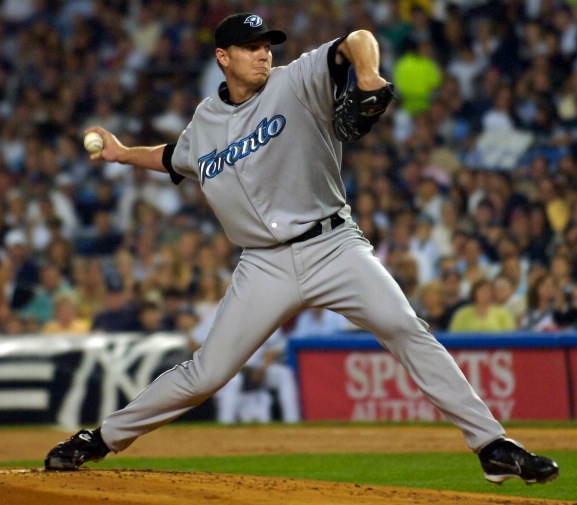Over the past four seasons, Roy Halladay has started 18 games against the Yankees, including 12 over the past two. In those 124 innings he’s struck out 84 Yankees and walked just 20, allowing 13 home runs and 38 runs, 34 earned, overall. That gives him an ERA of 2.47 and a FIP of 3.69, against his four-year rates of a 3.11 ERA and 3.26 FIP. Clearly, the Yankees are glad to have Halladay out of the division. His numbers, however, appear to be a bit out of line.

Photo credit: AP/Bill Kostroun)
The Yankees have scored more runs than any other team in the AL over the past four years, leading the league three times. How is it, then, that Halladay has performed better against them than he has against the rest of the league? The difference is quite large, over a half run per nine innings. Over the same, admittedly small, 124-inning sample, he would have allowed 43 runs to the rest of the league, and keeping with the same earned-to-unearned run ratio he would have allowed 48.
The easy, abstract narrative is that Halladay rises to the occasion. When facing the Orioles and the Royals he’s merely among the league’s best pitchers. When facing the very best offensive team in the American League, Halladay turns into something greater, a man without peer. Or, if we want to turn the narrative to the Yankees’ hitters, we can say that they beat up on weak pitchers, but show their true colors when facing the best. Either way, there’s not much evidence to substantiate such claims.
The Red Sox have sported formidable lineups over the past four years, and have contended with the Yankees in each season. They haven’t scored quite as many runs, but they’re still near the top. As against the Yankees, Halladay started 18 games against the Red Sox, and lasted two more innings. Yet his ERA, 3.64, and FIP, 4.12, are substantially higher — not only higher than the Yankees, but higher than his performance against the league. That distribution makes sense. While Halladay ranks among the best, he still probably faces more trouble from better teams. But still, not the Yankees.
The claim of the Yankees faltering against stronger competition is true, but it’s no more true for the Yankees than with any other team. Again, we expect that they’ll beat up on the weaker competition and struggle against the stronger. As we saw in the 2009 breakdowns, the Yankees fare all over the place against the league’s best pitchers. We also know that these performances come in small samples, and can fluctuate greatly from year to year. For instances, we saw Jon Lester absolutely dominate the Yankees in 2008 before they tattooed him in 2009.
That’s not to say that neither of those factors play into the results we’ve seen. Maybe Halladay does come into starts against the Yankees a bit more focussed than normal. Maybe the Yankees are a bit intimidated by him and take swing of a slightly lesser quality. Combine that with the low predictive value of short sample size numbers, and it’s not as difficult to understand why the Yankees performed worse against Halladay.
Another consideration lies in the FIP/ERA discrepancies. There’s an enormous gap when Halladay faces the Yankees, about 1.22 runs. Over the much larger four-year sample, 7.5 times larger than the one against the Yankees, Halladay’s ERA and FIP are separated by just 0.25 runs. As Halladay pitches more and more innings against the Yankees, I’d expect that discrepancy to lessen, moving Halladay’s numbers against the Yankees more in line with his career, or at least recent, rates — perhaps even higher, because of the Yankees’ potent offense. Similarly, I’d expect his numbers against the Red Sox to fall, though perhaps not all the way to his recent rates because, again, the Sox sport a better than average offense.
The good news for the Yankees is that they’ll be facing pitchers of a lesser quality than Halladay in 2010. As Kevin Long said, “It became a joke. Sometimes it felt as if he was out there on one day’s rest just to face us.” Chances are the Blue Jays won’t deliberately line up Halladay’s replacement to pitch against the Yankees whenever possible. Instead, the workload will be spread normally across the entire rotation. It means more of lesser pitchers, and it should improve the Yankees’ performance against the Blue Jays in 2010.
From Toronto’s view, however, that’s just fine. They made the trade knowing what they were giving up when facing the best of the AL East. The idea, so they hope, is to eventually replace Halladay with Kyle Drabek while upgrading the rest of their rotation, while improving their offense with Brett Wallace. The balance of power might shift a few years down the road, but for 2010 the Yankees should see something of an improvement against the Jays.